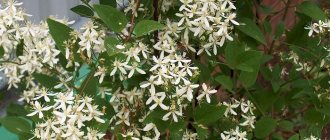Author: Elena N. https://floristics.info/ru/index.php?option=com_contact&view=contact&id=19 Category: Garden plants Published: January 25, 2019Last edits: June 01, 2021
- Growing conditions
- Reproduction methods
- Autumn work
- Common or pale mock orange (Philadelphus pallidus)
plant (lat. Philadelphus) , or garden jasmine , belongs to the genus of deciduous and semi-deciduous shrubs of the Hydrangeaceae family. We are accustomed to calling the mock orange flower jasmine for its characteristic sweetish aroma and the similarity of the flowers of these two plants. The Latin name mock orange-Philadelphus was given in honor of the king of Egypt Ptolemy Philadelphus, and it is called mock orange because its strong wood with a soft core was used to make chibouks and mouthpieces for smoking pipes. In the wild, the mock orange shrub is common in North America, Europe and East Asia. According to various sources, there are from 50 to 70 species of mock orange in nature, and a large number of varieties of this plant have been cultivated.
Planting and caring for mock orange
- Planting: from mid-September to mid-October, but if necessary, in the spring, before the buds swell.
- Flowering: from late May to late July.
- Lighting: bright sunlight
- Soil: permeable, light and fertile soil.
- Watering: once a week, using 2-3 buckets of water for each plant. During the flowering period, watering is carried out almost every day.
- Feeding: in the spring - a bucket of slurry (1:10) for each bush, after flowering, wood ash is scattered in the tree trunk circle, and then watered. Mineral fertilizers can be applied only from the fourth year of the mock orange’s life, and nitrogen fertilizers only in the spring.
- Pruning: in autumn – sanitary, in spring – sanitary and formative.
- Reproduction: seeds, cuttings, layering and dividing the bush.
- Pests: bean aphids, green leaf weevils, hawthorns, click beetles, spider mites.
- Diseases: gray rot, septoria.
Read more about growing mock orange below.
Possible problems
Gardeners may encounter a number of problems when growing mock orange. The most common of them include:
- curling and falling of leaves. This may indicate insufficient or irregular watering. Setting up automatic watering will help correct the situation;
- lack of flowering. This point may be associated with an incorrectly chosen planting site, inappropriate soil, or the presence of a large amount of nitrogen in the fertilizer.
Botanical description
Numerous stems of all shrubs of this genus are covered with thin gray bark. The bark of young shoots is mostly brown and peeling. The mock orange wood is hard and the core is wide. Simple leaves from 2 to 7 cm long, depending on the type, are elongated, ovate or broadly ovate. Typically, fragrant, simple, semi-double or double mock orange flowers, collected in racemes, are formed at the ends of young shoots. The mock orange fruit is a three- to five-sided capsule with small seeds.
Garden mock orange is winter-hardy, but each type of plant behaves differently depending on the climatic conditions of the area where it grows. However, even if the mock orange bush is severely damaged by frost in a harsh winter, only its above-ground part will die, and if you prune it in the spring, then, thanks to the powerful root system of the plant, the mock orange will very quickly grow back and restore its decorative appearance.
Application
Who hasn’t drunk green tea with jasmine flowers, the properties of which give the drink a unique range of smells? This combination is so loved by consumers that today it can be found in any store. It is also used as a flavoring agent for confectionery products, alcoholic beverages and other food products.
It is curious that photos of jasmine flowers on tea boxes are sometimes images of mock orange. These plants are often confused due to their similar aroma and appearance.
In addition to its decorative and gastronomic value, some of the properties of this universal plant have found application in folk medicine and medical cosmetology.
Planting mock orange
When to plant
Mock orange is planted in open sunny areas, where it will bloom luxuriantly and smell fragrant. In the shade, the flowers of the shrub bloom small, and the shoots become too elongated. The optimal soil composition for mock orange is humus, sand and leaf soil in a ratio of 1:2:3, and if the soil on the site does not have good water permeability, then a drainage layer is added to the hole when planting.
- Wisteria: growing in the garden, types and varieties
It is better to plant mock orange in the fall, from mid-September to mid-October. You can plant mock orange in the spring, but planting mock orange in spring is complicated by the fact that you need to do it before the buds open on the trees.
How to plant
If you are planting several bushes, then dig holes at a distance of 50 to 150 cm, depending on how mature the plant will be. If you decide to plant a mock orange hedge, then the seedlings are planted at a distance of 50-70 cm from each other. A drainage layer of broken brick and sand 15 cm thick is poured into a hole measuring 60x60x60, then a layer of soil mixture, the composition of which is described in the previous section. It is advisable to do this a week or two before planting the mock orange.
When the soil settles, the root of the seedling is immersed in the hole so that its root collar is flush with the surface of the site, then the hole is filled with fertile soil. After planting, mock orange seedlings are moistened abundantly by pouring 2-3 buckets of water under each. When the soil settles after watering, add dry soil to the holes. It doesn’t matter if, after precipitation, the root collar sinks 3 cm into the soil, but this is the maximum safe depth - if the root collar is deeper, it may rot.
A day or two after planting, mulch the tree trunk circle with peat or sawdust with a layer of 3-4 cm.
Growing
When planting jasmine in our difficult latitudes, you need to take into account the following nuances:
- the plant is not particularly demanding on the mineral composition of the soil, but if you need an intoxicating aroma and abundant flowering, it must be fertile;
- plant either in early spring or late autumn - this is the best time for rooting;
- You should pay close attention to the behavior of groundwater and water circulation in the area as a whole, and plant only in places that are not subject to stagnant water, or neutralize them using crushed stone cushions.
The hole for planting jasmine should be about half a meter deep, and you need to add a little nitrogen-phosphorus fertilizer to it. After planting and compacting, it is necessary to water abundantly.
Caring for mock orange
Growing conditions
If the plant lacks moisture, its leaves will tell you about it. Mock oranges do not tolerate drought well, and in the hottest part of summer, their leaves lose turgor and droop without sufficient watering. It is recommended to water the mock orange weekly with two or three buckets of water, and during the flowering period, watering will have to be done almost daily. After moistening the soil in the area, you need to loosen the soil around the bushes and remove weeds. We remind you: if you mulched the area in the spring, then you will have to water, loosen and weed the soil much less often.
As for the mock orange’s nutrition, it responds best to the application of slurry (in a ratio of 1:10) - one bucket of this fertilizer is poured once a year under each adult mock orange bush, and it is advisable to do this in the spring. After flowering, mock orange is fertilized with wood ash, scattering it around the tree trunk before watering. From the fourth year of life, you can carry out spring fertilizing with complex mineral fertilizers at the rate of 30 g of superphosphate, 15 g of urea and the same amount of potassium sulfate per bucket of water, which should be enough for two adult bushes.
After flowering, 15 g of potassium sulfate and 25 g of superphosphate are added per 1 m² of area. Potassium can be replaced by scattering 100-150 g of wood ash under each bush. Nitrogen fertilizers are applied only in spring.
Trimming
If you want to see lush mock orange blossoms every year, you need to trim it regularly. The peculiarity of the plant is that only strong shoots from the previous year bloom profusely, and on thin and weak old branches, flowers, if they appear, are in much smaller quantities, and because of this the bush looks disheveled. Therefore, after the mock orange has faded, you need to prune the faded branches to this year’s strong shoots, which are located below.
Please note: over time, this year's young growths become more powerful, which means that next year you can expect abundant flowering from them.
Pruning mock orange in the fall also involves sanitary clearing of the bush: branches and shoots that thicken the crown are removed, as well as dry, painful or broken ones. Once every three years, remove shoots that are older than 12 years. Anti-aging pruning is done in early spring: several trunks are shortened to 30 cm, the rest are cut to soil level. The cuttings are treated with garden varnish, and the soil around the bush is mulched with peat. By autumn, strong young shoots will grow from dormant buds. But before you prune the mock orange, make sure that sap flow has not yet begun.
Transfer
Mock orange tolerates replanting easily, especially if you take this procedure responsibly, but you will have to sacrifice its lush crown and thereby lose a year of flowering. First you need to prepare a hole for the bush - two weeks before replanting, so that the earth settles. Then you need to abundantly water the bush that you are going to replant; after a day, remove half of the old shoots at the root, and shorten the rest. Now you can dig up the bush and move it to a new place, not forgetting to water it thoroughly after replanting.
The timing when mock orange can be replanted coincides with the timing of its primary planting - from mid-September to mid-October or in the spring, while the buds have not yet opened. However, replanting mock orange in the fall is much more convenient in the sense that you are not pressed for time, which means you can do this work more efficiently.
Pests and diseases
Among the few enemies of mock orange are bean aphids, spider mites and green leaf weevils. Aphids are destroyed by treating the bushes with Karbofos or Rogor in accordance with the instructions.
- How to sow petunia to obtain 100% germination - advice from an experienced gardener!
In the fight against spider mites, products such as a three percent Keltan emulsion or a two percent Phosfamide solution, which are used to treat mock orange bushes two to three times at intervals of a week, have proven themselves well. And weevil larvae and beetles die from spraying with Chlorophos.
Mock orange in Siberia and the Moscow region
Readers often ask questions about which mock orange is more suitable for the Moscow region and whether this plant can be grown in Siberia. Mock orange is not a capricious plant at all, and it is also frost-resistant, so there are no big differences in the conditions for its cultivation in the southern regions or in the Moscow region. As for Siberia, there are winter-hardy varieties of mock orange with a viable root system that can withstand frosts down to -35 ºC without shelter! And if you consider that there is always a lot of snow in Siberia, you don’t have to worry about the wintering of less hardy species and varieties.
Error with title
Very often in the country it is called jasmine. This happens out of ignorance, because plants differ significantly from each other in description, growth form and other characteristics.
Mock orange (Philadelphus) is a deciduous tree-like shrub with thin gray bark, characterized by multiple flowering on its shoots. It got its name from the use of parts of the stem for making smoking pipes. Grows freely on the territory of the Russian Federation.
Jasmine (Jasminum) is a climbing vine or erect green stem with a characteristic strong aroma that opens after sunset. Grown in the subtropics or tropics.
Related article:
How to protect garden trees from frost?
On the left is Lewis’s mock orange “Waterton”, on the right is Indian Jasmine
Reproduction of mock orange
Reproduction methods
Planting and caring for mock orange is simple and easy, and methods for propagating garden jasmine will not seem complicated to you either. Mock orange reproduces generatively (by seeds) and vegetatively - by dividing the bush, cuttings and layering. And although propagation by seeds in the case of mock orange is much simpler than with other plants, varietal mock oranges are propagated vegetatively, since seedlings do not always inherit the characteristics of their parents.
Growing from seeds
Before sowing, mock orange seeds need two months of stratification at a temperature of 2-3 ºC. To do this, they are mixed with wet sand and peat in January, placed in a container and kept in the vegetable drawer of the refrigerator until spring.
In March, the seeds are sown in boxes filled with a soil mixture of leaf soil, humus and peat in a ratio of 1:1:2 with the addition of half a part of sand, sprinkled with sand on top and covered with glass. The soil is kept slightly moist, using a sprayer for watering - you will have to spray the crops two to three times a day. After a week or a week and a half, expect seedlings to emerge and, as soon as they develop several leaves, transplant the seedlings into open ground, providing them with protection from the sun for the first time.
Propagation by green cuttings
This method of propagation is the most reliable, since it gives 100% rooting. Cuttings are cut from developed large shoots, but for this purpose you should not take growth shoots with a wide hollow core and a large distance between the buds, since there is a high probability of putrefactive processes developing in these cavities.
The best planting material is green cuttings with a heel - annual shoots with part of last year's shoot. The cut of the cutting with the heel is treated with a root-forming preparation, planted in containers with a mixture of nutrient soil and sand to a depth of 0.5 cm according to the 40x10 pattern, covered with a plastic or glass cap to create greenhouse conditions and placed under diffused light. During rooting, cuttings need frequent spraying.
Reproduction by layering
Layerings of mock orange are easy to form, and their rooting rate is also very high – 50-70%. It is best to propagate mock orange by layering after anti-aging pruning, when the bush is cut at a height of 5-7 cm from the surface level. The soil around the bush is dug up, fertilized and leveled.
A young shoot is pulled with a soft wire near the lower bud, placed in a pre-dug groove 1.5 cm deep, secured and buried. In this way, you can take several shoots from one bush, arranging them radially, and by the end of the growing season you will have several plants with a powerful root system. The following spring they are separated from the mother plant, dug up and grown for another two years.
Dividing the bush
In the spring before the sap begins to flow or in the fall after the leaves fall, the overgrown mock orange is dug up, divided into several parts and quickly planted in new places so that the divisions do not have time to dry out. When dividing the bush, old branches that thicken the bush are removed, and young shoots are dug up.
Briefly about the plant
Since mock orange saturates the garden with a wonderful aroma, gardeners often call it jasmine. The bush blooms with boiling white flowers.
Jasmine is an upright growing shrub that is covered with a gray crown, and in the fall sheds leaves, the color of which changes from green to yellow. Considering the height of the bush, it can be dwarf (up to 70 centimeters), medium or large (up to six meters). The leaves of the plant resemble the shape of an egg, slightly elongated and wide. The length of the leaves is 2 – 7 centimeters. Leaves can be double or semi-double. Jasmine blooms for two to three weeks. If you choose the right plant varieties, mock orange will bloom throughout the summer:
- in June, small-leaved varieties bloom, only one meter high with small leaves and beautiful bowing shoots. This mock orange smells like strawberries, so it attracts both people and insects;
- the thin-leaved variety of jasmine also blooms in the first rows. Its height is more than two meters;
- At the end of summer, varieties that have large leaves and dense crowns bloom.
Gardeners plant species and varietal plants on their territories, since mock oranges do not need special care and are not too whimsical. But for the winter, the bushes must be covered so that they do not disappear due to the cold winter weather.
Against the background of brick walls, you can plant a luxurious, vigorous, spreading bush. It will harmoniously and effectively decorate the largest garden.
Mock orange combines harmoniously with weigela, hydrangea, and lilac. It will stand out brightly among trees with bright leaves or an openwork crown. In autumn, jasmine with yellow leaves will go well with plants that have purple leaves (maple or hazel).
Types and varieties
Several species of mock orange and many varieties bred by breeders are grown in cultivation.
Common or pale mock orange (Philadelphus pallidus)
Originally from the south of Western Europe and the Caucasus. It is this species that is the first of the mock oranges to bloom in the Moscow region. The height of the common mock orange can reach 3 m, its shoots are erect and bare. Leaves up to 8 cm long are simple, oblong, elliptical, with sparse serrations along the edges and a pointed apex; the upper side of the leaf is bare, bright green, the lower side is pubescent, pale green. White-cream flowers up to 3 cm in diameter with a strong pleasant aroma are collected in 5-7 pieces in racemes.
- Tansy: properties, cultivation, types and varieties
The species is winter-hardy and can withstand temperatures down to -25 ºC. It has several decorative forms: golden, large-flowered, terry, silver-edged, willow-leaved and low. Of the varieties more popular than others:
- Virgin mock orange is a variety created by Lemoine in 1909, 2 to 3 m high, with a wide crown, brown shoots and peeling bark. The leaves are up to 7 cm long, pointed, oval, dark green, yellow in autumn. It blooms in July with racemose inflorescences up to 14 cm long from white double flowers with a diameter of up to 5 cm. The decorative effect of this variety lasts up to 20 years;
- Mock orange Belle Etoile is the main achievement of Emile Lemoine as a breeder. In our conditions, a bush of this variety rarely grows above a meter, although in France it grows one and a half times higher. The leaves of this variety have a retracted tip and are small; flowers with a strawberry aroma, simple, bell-shaped, with a large carmine spot in the middle, reach a diameter of 4 cm;
- mock orange Bicolor - has single flowers crowning the lateral axillary shoot and reaching a diameter of 5 cm. The bush is fluffy, height - up to 2 m. This variety is often used in landscaping.
Crown mock orange (Philadelphus coronarius)
A southern European species up to 3 m high, found naturally in the Caucasus, Asia Minor and Southern Europe. It has yellowish or reddish-brown young shoots with cracked bark and dense foliage. The leaves are opposite, oval, with sparse teeth along the edges, petiolate, glabrous on the upper side, pubescent along the veins on the lower side. Fragrant creamy flowers up to 5 cm in diameter are collected in racemose terminal inflorescences of 5-7 pieces. This species blooms for up to three weeks.
Smoke-, gas-, cold-resistant - withstands frosts down to -25 ºC. The best varieties:
- Aureus is a fast-growing shrub 2-3 m high with a spherical crown of bright yellow leaves, which become yellow-green by summer and remain that way until the leaves fall. Numerous flowers against the background of leaves are almost indistinguishable, but the fact that the bush has bloomed can be determined even from afar by its amazing aroma. The value of the variety is represented by the mock orange leaf of unusual color and the strong aroma of its flowers;
- Variegatus, or Bowles Variety , is a shrub up to 3 m high with a creamy, wide, uneven stripe along the edges of the leaves;
- Innosense is a compact bush of medium size - no higher than 2 m - with single white simple flowers and a strong aroma. Leaves with uneven cream spots.
Lemoine mock orange (Philadelphus x lemoinei)
A hybrid between small-leaved mock orange and common mock orange. In culture, it is widespread in Europe and North America. This species reaches a height of 3 m, it has spreading branches with ovoid lanceolate leaves up to 4 cm long and large white fragrant flowers collected in brushes of 3-7 pieces. This hybrid has many varieties that have gained wide popularity among professionals and amateurs:
- Ermine Mantle (Manto d'Ermine) - a bush no higher than 1 m with graceful semi-double white flowers that bloom profusely for up to a month and a half;
- mock orange Schneersturm is a girlish mock orange with fragrant white flowers with a diameter of 2-2.5 cm, collected in racemes; The leaves are large, dark green, turning yellow in autumn. Bush up to 2 m high;
- Glacier - double mock orange with bunches of large fragrant white flowers that bloom for about three weeks; bush up to 2 m high;
- Charm is one of the most beautiful mock oranges: densely double large snow-white flowers, almost odorless, are collected in inflorescences of 9 or more pieces on a bush up to 2 m high. The disadvantage of this variety is that its lower part is exposed, so for To restore its decorative effect, professionals recommend planting low-growing shrubs in front of it;
- mock orange Snow Storm - bush up to 2 m high; double white flowers are collected in inflorescences of 7-9 pieces and bloom profusely for about three weeks.
In addition to the described species, Schrenk's, Gordon's, broad-leaved, thin-leaved, grayish, fluffy, odorless, small-leaved, large-flowered and Caucasian mock oranges are grown in culture.
Chronology of double petals
Among the natural types of garden jasmine, or more correctly, mock orange, there are hardly any double forms. Most wild plants are characterized by simple, tasty-smelling flowers of small or medium size.
The history of double mock orange flowers begins in 1909 and is associated with the Lemoines family of talented French breeders. By experimenting with the common Chubushnik, the originator managed to develop the first terry variety Virginal, which has remained a favorite for many gardeners for more than 100 years. Lemoine's terry mock oranges resemble small roses in half-bloom.
An equally significant contribution to the development of new varieties, including terry varieties, was made by the domestic originator N. Vekhov, who devoted most of his life to jasmine and did not stop breeding research even during the Great Patriotic War.
The first half of the 20th century was the peak of popularity of garden jasmine, the period when most of the varieties and hybrids that are still used in ornamental gardening were obtained.
Note! The terry group of mock oranges is not uniform. Semi-double varieties are distinguished from it - Alabaster, Elbrus, Norma, Dame Blanche. And there are also densely double hybrids, such as Pearl, Argentina, Engagement.











